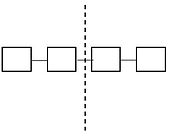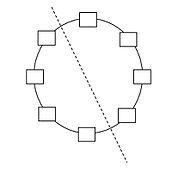|
Bisection bandwidthIn computer networking, a network may be bisected into two equal-sized partitions. The bisection bandwidth of a network topology is the minimum bandwidth available between any two such partitions.[1] Given a graph with vertices , edges , and edge weights , the bisection bandwidth of is . In other words, the network is bisected s in such a way that the bandwidth between the two partitions is minimum.[2] A network is considered to have full bisection bandwidth if .[3] Intuitively, full bisection bandwidth means that if all vertices in the network are matched as source-destination pairs, then if all pairs send flow at rate 1 simultaneously, there are no bisection bottlenecks. Therefore, bisection bandwidth accounts for the bottleneck bandwidth of the bisected network as a whole. Bisection bandwidth calculationsFor a linear array with n nodes bisection bandwidth is one link bandwidth. For linear array only one link needs to be broken to bisect the network into two partitions.  For ring topology with n nodes two links should be broken to bisect the network, so bisection bandwidth becomes bandwidth of two links.  For tree topology with n nodes can be bisected at the root by breaking one link, so bisection bandwidth is one link bandwidth.  For Mesh topology with n nodes, links should be broken to bisect the network, so bisection bandwidth is bandwidth of links.  For Hyper-cube topology with n nodes, n/2 links should be broken to bisect the network, so bisection bandwidth is bandwidth of n/2 links.  Significance of bisection bandwidthTheoretical support for the importance of this measure of network performance was developed in the PhD research of Clark Thomborson (formerly Clark Thompson).[4] Thomborson proved that important algorithms for sorting, Fast Fourier transformation, and matrix-matrix multiplication become communication-limited—as opposed to CPU-limited or memory-limited—on computers with insufficient bisection bandwidth. F. Thomson Leighton's PhD research[5] tightened Thomborson's loose bound [6] on the bisection bandwidth of a computationally-important variant of the De Bruijn graph known as the shuffle-exchange network. Based on Bill Dally's analysis of latency, average-case throughput, and hot-spot throughput of m-ary n-cube networks[2] for various m, it can be observed that low-dimensional networks, in comparison to high-dimensional networks (e.g., binary n-cubes) with the same bisection bandwidth (e.g., tori), have reduced latency and higher hot-spot throughput.[7] Note, there is also support that bisection bandwidth and network throughput are asymptotically different metrics, which may grow at different rates depending on the network topology. [3][8] References
|
Portal di Ensiklopedia Dunia






